Hyundai Creta 2019 Owner's Manual
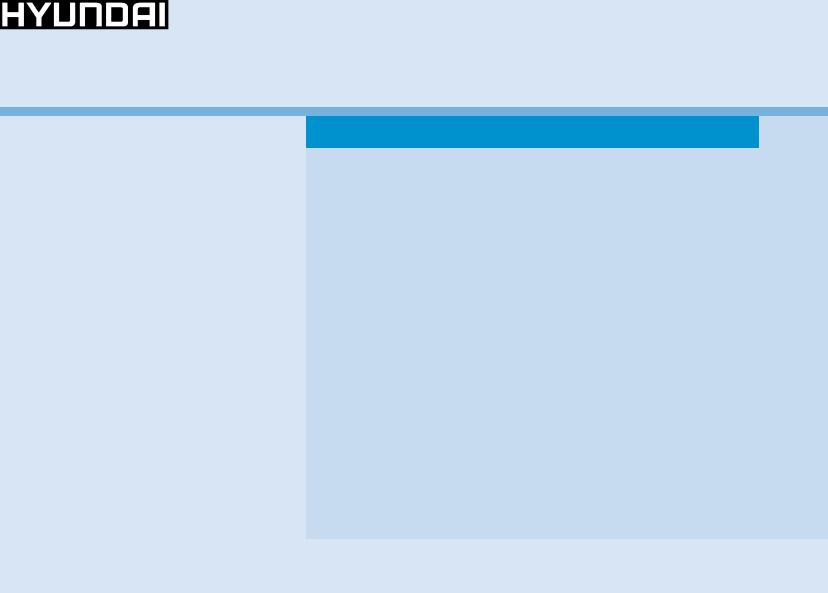
OWNER'S MANUAL
Operation
Maintenance
Specifications
All information in this Owner's Manual is current at the time of publication. However, HYUNDAI reserves the right to make changes at any time so that our policy of continual product improvement may be carried out.
This manual applies to all models of this vehicle and includes descriptions and explanations of optional as well as standard equipment.
As a result, you may find material in this manual that does not apply to your specific vehicle.
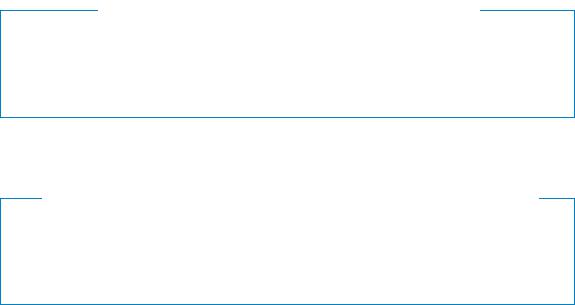
CAUTION: MODIFICATIONS TO YOUR HYUNDAI
Your HYUNDAI should not be modified in any way. Such modifications may adversely affect the performance, safety or durability of your HYUNDAI and may, in addition, violate conditions of the limited warranties covering the vehicle. Certain modifications may also be in violation of regulations established by the Department of Transportation and other government agencies in your country.
TWO-WAY RADIO OR CELLULAR TELEPHONE INSTALLATION
Your vehicle is equipped with electronic fuel injection and other electronic components. It is possible for an improperly installed/adjusted two-way radio or cellular telephone to adversely affect electronic systems. For this reason, we recommend that you carefully follow the radio manufacturer's instructions or consult your HYUNDAI dealer for precautionary measures or special instructions if you choose to install one of these devices.
F2
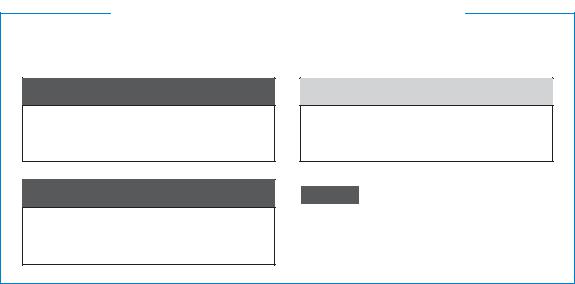
SAFETY AND VEHICLE DAMAGE WARNING
This manual includes information titled as DANGER, WARNING, CAUTION and NOTICE. These titles indicate the following:
 DANGER
DANGER
DANGER indicates a hazardous situation which, if not avoided, will result in death or serious injury.
 CAUTION
CAUTION
CAUTION indicates a hazardous situation which, if not avoided, could result in minor or moderate injury.
 WARNING
WARNING
WARNING indicates a hazardous situation which, if not avoided, could result in death or serious injury.
NOTICE
NOTICE indicates a situation which, if not avoided, could result in vehicle damage.
F3

FOREWORD
Thank you for choosing HYUNDAI. We are pleased to welcome you to the growing number of discriminating people who drive HYUNDAI. The advanced engineering and high-quality construction of each HYUNDAI we build is something of which we're very proud.
Your Owner's Manual will introduce you to the features and operation of your new HYUNDAI. It is suggested that you read it carefully because the information it contains can contribute greatly to the satisfaction you receive from your new car.
The manufacturer also recommends that service and maintenance on your vehicle be performed by an authorized HYUNDAI dealer.
HYUNDAI MOTOR COMPANY
Note : Because future owners will also need the information included in this manual, if you sell this HYUNDAI, please leave the manual in the vehicle for their use. Thank you.
 CAUTION
CAUTION
Severe engine and transaxle damage may result from the use of poor quality fuels and lubricants that do not meet HYUNDAI specifications. You must always use high quality fuels and lubricants that meet the specifications listed on Page 8-5 in the Vehicle Specifications section of the Owner's Manual.
Copyright 2018 HYUNDAI Motor Company. All rights reserved. No part of this publication may be reproduced, stored in any retrieval system or transmitted in any form or by any means without the prior written permission of HYUNDAI Motor Company.
F4

HOW TO USE THIS MANUAL
We want to help you get the greatest possible driving pleasure from your vehicle. Your Owner’s Manual can assist you in many ways. We strongly recommend that you read the entire manual. In order to minimize the chance of death or injury, you must read the DANGER, WARNING and CAUTION sections in the manual.
Illustrations complement the words in this manual to best explain how to enjoy your vehicle. By reading your manual, you will learn about features, important safety information, and driving tips under various road conditions.
The general layout of the manual is provided in the Table of Contents. Use the index when looking for a specific area or subject; it has an alphabetical listing of all information in your manual.
Sections: This manual has eight chapters plus an index. Each section begins with a brief list of contents so you can tell at a glance if that section has the information you want.
Your safety, and the safety of others, is very important. This Owner's Manual provides you with many safety precautions and operating procedures. This information alerts you to potential hazards that may hurt you or others, as well as damage to your vehicle.
Safety messages found on vehicle labels and in this manual describe these hazards and what to do to avoid or reduce the risks.
Warnings and instructions contained in this manual are for your safety. Failure to follow safety warnings and instructions can lead to serious injury or death.
Introduction
Throughout this manual DANGER, WARNING, CAUTION, NOTICE and the SAFETY ALERT SYMBOL will be used.
This is the safety alert symbol. It is used to alert you to potential physical injury hazards. Obey all safety messages that follow this symbol to avoid possible injury or death. The safety alert symbol precedes the signal words DANGER, WARNING and CAUTION.
 DANGER
DANGER
DANGER indicates a hazardous situation which, if not avoided, will result in death or serious injury.
 WARNING
WARNING
WARNING indicates a hazardous situation which, if not avoided, could result in death or serious injury.
F5
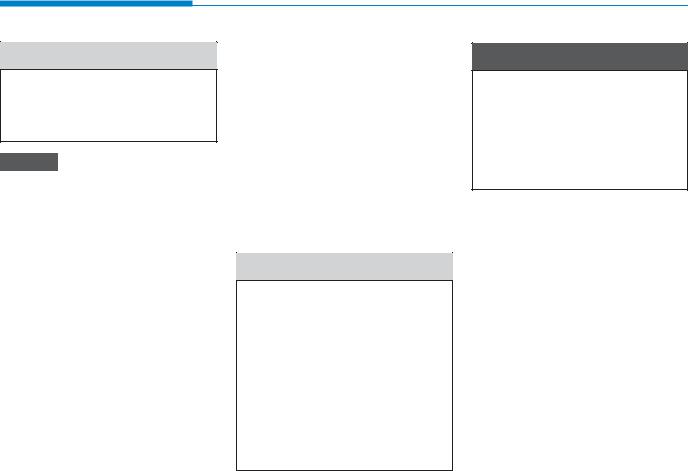
Introduction
 CAUTION
CAUTION
CAUTION indicates a hazardous situation which, if not avoided, could result in minor or moderate injury.
NOTICE
NOTICE indicates a situation which, if not avoided, could result in vehicle damage.
FUEL REQUIREMENTS
Gasoline engine
Unleaded
Your new vehicle is designed to use only unleaded fuel having an Octane Rating of RON (Research Octane Number) 91 / AKI (Anti-Knock Index) 87 or higher.
Your new vehicle is designed to obtain maximum performance with UNLEADED FUEL, as well as minimize exhaust emissions and spark plug fouling.
 CAUTION
CAUTION
NEVER USE LEADED FUEL. The use of leaded fuel is detrimental to the catalytic converter and will damage the engine control system’s oxygen sensor and affect emission control.
Never add any fuel system cleaning agents to the fuel tank other than what has been specified (We recommend that you consult an authorized HYUNDAI dealer for details.)
 WARNING
WARNING
•Do not "top off" after the nozzle automatically shuts off when refueling.
•Always check that the fuel cap is installed securely to prevent fuel spillage in the event of an accident.
Leaded (if equipped)
For some countries, your vehicle is designed to use leaded gasoline.
When you are going to use leaded gasoline, we recommend that you ask an authorized HYUNDAI dealer whether leaded gasoline in your vehicle is available or not.
Octane Rating of leaded gasoline is same with unleaded one.
F6
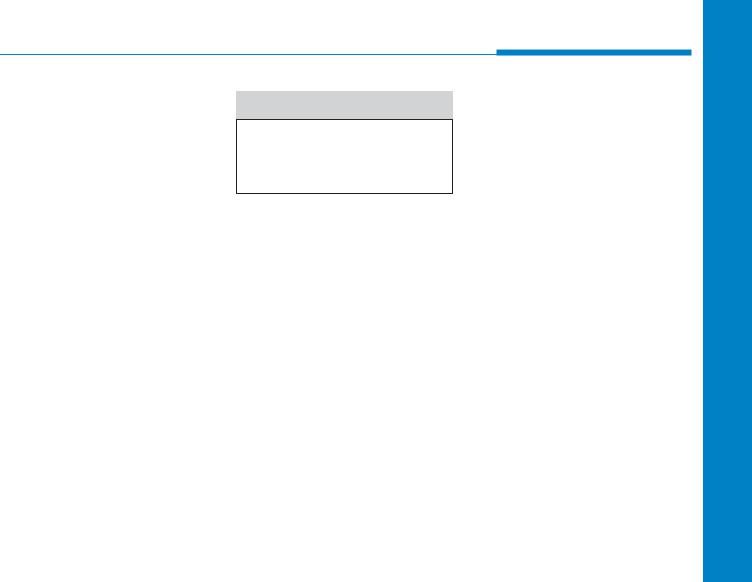
Gasoline containing alcohol and methanol
Gasohol, a mixture of gasoline and ethanol (also known as grain alcohol), and gasoline or gasohol containing methanol (also known as wood alcohol) are being marketed along with or instead of leaded or unleaded gasoline.
Do not use gasohol containing more than 10% ethanol, and do not use gasoline or gasohol containing any methanol. Either of these fuels may cause drivability problems and damage to the fuel system, engine control system and emission control system.
Discontinue using gasohol of any kind if drivability problems occur.
Vehicle damage or driveability problems may not be covered by the manufacturer’s warranty if they result from the use of:
1.Gasohol containing more than 10% ethanol.
2.Gasoline or gasohol containing methanol.
3.Leaded fuel or leaded gasohol.
 CAUTION
CAUTION
Never use gasohol which contains methanol. Discontinue use of any gasohol product which impairs drivability.
Introduction
Other fuels
Using fuels such as
-Silicone (Si) contained fuel,
-MMT (Manganese, Mn) contained fuel,
-Ferrocene (Fe) contained fuel, and
-Other metalic additives contained fuels,
may cause vehicle and engine damage or cause plugging, misfiring, poor acceleration, engine stalling, catalyst melting, abnormal corrosion, life cycle reduction, etc.
Also, the Malfunction Indicator Lamp (MIL) may illuminate.
NOTICE
Damage to the fuel system or performance problem caused by the use of these fuels may not be covered by your New Vehicle Limited Warranty.
F7
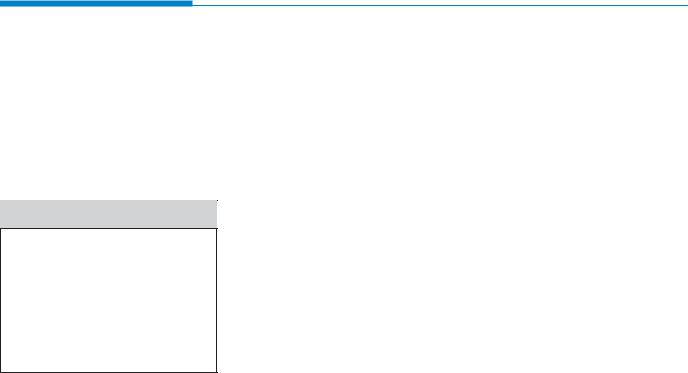
Introduction
Use of MTBE
HYUNDAI recommends avoiding fuels containing MTBE (Methyl Tertiary Butyl Ether) over 15.0% vol. (Oxygen Content 2.7% weight) in your vehicle.
Fuel containing MTBE over 15.0% vol. (Oxygen Content 2.7% weight) may reduce vehicle performance and produce vapor lock or hard starting.
 CAUTION
CAUTION
Your New Vehicle Limited Warranty may not cover damage to the fuel system and any performance problems that are caused by the use of fuels containing methanol or fuels containing MTBE (Methyl Tertiary Butyl Ether) over 15.0% vol. (Oxygen Content 2.7% weight.)
Do not use methanol
Fuels containing methanol (wood alcohol) should not be used in your vehicle. This type of fuel can reduce vehicle performance and damage components of the fuel system, engine control system and emission control system.
Fuel Additives
HYUNDAI recommends that you use unleaded gasoline which has an octane rating of RON (Research Octane Number) 95 / AKI (Anti Knock Index) 91 or higher (for Europe) or Octane Rating of RON (Research Octane Number) 91 / AKI (Anti-Knock Index) 87 or higher (except Europe).
For customers who do not use good quality gasolines including fuel additives regularly, and have problems starting or the engine does not run smoothly, one bottle of additives added to the fuel tank at every 5,000 km.
Additives are available from your authorized HYUNDAI dealer along with information on how to use them. Do not mix other additives.
Operation in foreign countries
If you are going to drive your vehicle in another country, be sure to:
•Observe all regulations regarding registration and insurance.
•Determine that acceptable fuel is available.
F8
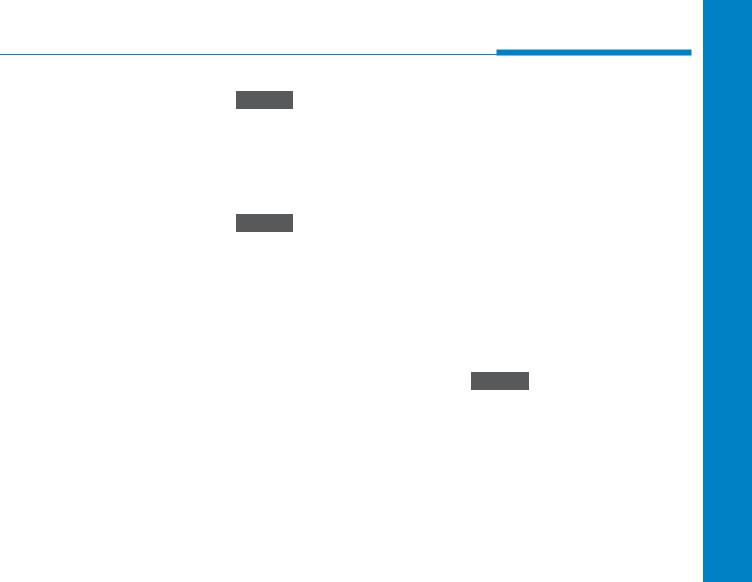
Introduction
Diesel engine
Diesel fuel
Diesel engine must be operated only on commercially available diesel fuel that complies with EN 590 or comparable standard. (EN stands for "European Norm"). Do not use marine diesel fuel, heating oils, or non-approved fuel additives, as this will increase wear and cause damage to the engine and fuel system. The use of non-approved fuels and / or fuel additives will result in a limitation of your warranty rights.
Diesel fuel of above cetane 51 is used in your vehicle. If two types of diesel fuel are available, use summer or winter fuel properly according to the following temperature conditions.
•Above -5°C (23°F) ... Summer type diesel fuel.
•Below -5°C (23°F) ... Winter type diesel fuel.
Watch the fuel level in the tank very carefully : If the engine stops through fuel failure, the circuits must be completely purged to permit restarting.
NOTICE
Do not let any gasoline or water enter the tank. This would make it necessary to drain it out and to bleed the lines to avoid jamming the injection pump and damaging the engine.
NOTICE
-Diesel Fuel
(if equipped with DPF)
It is recommended to use the regulated automotive diesel fuel for diesel vehicle equipped with the DPF system.
If you use diesel fuel including high sulfur (more than 50 ppm sulfur) and unspecified additives, it can cause the DPF system to be damaged and white smoke can be emitted.
Biodiesel
Commercially supplied Diesel blends of no more than 7% biodiesel, commonly known as "B7 Diesel" may be used in your vehicle if Biodiesel meets EN 14214 or equivalent specifications. (EN stands for "European Norm"). The use of biofuels exceeding 7% made from rapeseed methyl ester (RME), fatty acid methyl ester (FAME), vegetable oil methyl ester (VME) etc. or mixing diesel exceeding 7% with biodiesel will cause increased wear or damage to the engine and fuel system. Repair or replacement of worn or damaged components due to the use of non approved fuels will not be covered by the manufactures warranty.
NOTICE
•Never use any fuel, whether diesel, B7 biodiesel or otherwise, that fails to meet the latest petroleum industry specification.
•Never use any fuel additives or treatments that are not recommended or approved by the vehicle manufacturer.
F9
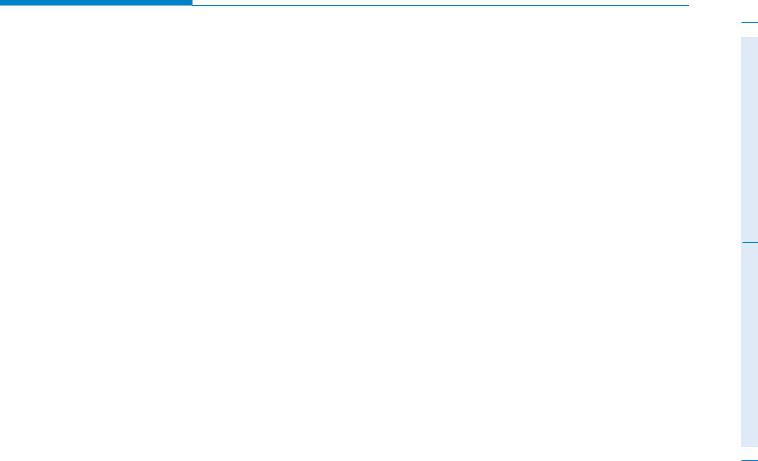
Introduction
VEHICLE BREAK-IN
PROCESS
No special break-in period is needed. By following a few simple precautions for the first 1,000 km (600 miles) you may add to the performance, economy and life of your vehicle:
•Do not race the engine.
•While driving, keep your engine speed (rpm, or revolutions per minute) between 2,000 rpm and 4,000 rpm.
•Do not maintain a single speed for long periods of time, either fast or slow.
Varying engine speed is needed to properly break-in the engine.
•Avoid hard stops, except in emergencies, to allow the brakes to seat properly.
•Don't tow a trailer during the first 2,000 km (1,200 miles) of operation.
F10

|
|
|
Your vehicle at a glance |
|
1 |
|
|
|
|
|
|
|
|
|
|
|
|
|
|
|
|
|
|
Safety system of your vehicle |
|
2 |
|
|
|
|
|
|
|
|
|
|
|
|
|
|
|
|
|
|
Convenient features of your vehicle |
|
3 |
|
|
|
|
|
|
|
|
|
|
|
|
|
|
|
|
|
|
Multimedia System |
|
4 |
|
TABLE OF CONTENTS |
|
|
|
|
|
|
|
|
|
|
|
|
|
|
Driving your vehicle |
|
5 |
|
||
|
|
|
|
|
||
|
|
|
|
|
|
|
|
|
|
|
|
|
|
|
|
|
What to do in an emergency |
|
6 |
|
|
|
|
|
|
|
|
|
|
|
|
|
|
|
|
|
|
Maintenance |
|
7 |
|
|
|
|
|
|
|
|
|
|
|
|
|
|
|
|
|
|
Specifications & Consumer information |
|
8 |
|
|
|
|
|
|
|
|
|
|
|
|
|
|
|
|
|
|
Index |
|
I |
|
|
|
|
|
|
|
|
|
|
|
|
|
|
|
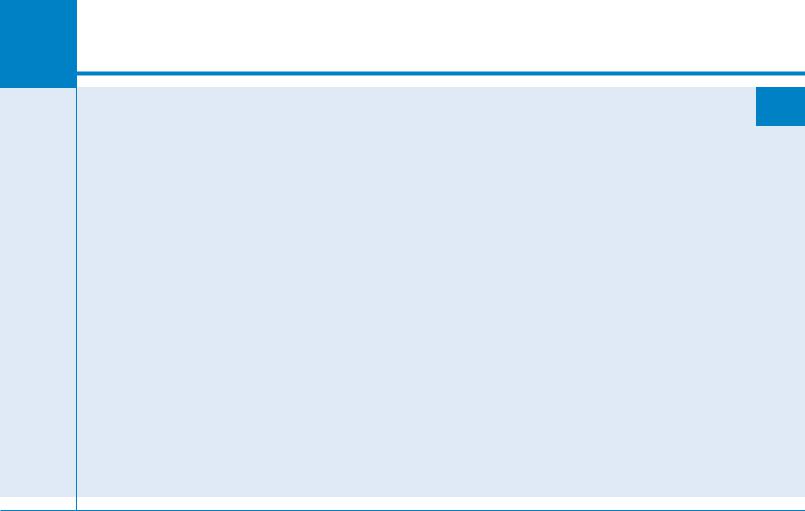
Your vehicle at a glance
Exterior overview (I) ............................................. |
1-2 |
Exterior overview (II) ............................................ |
1-3 |
Interior overview (I) .............................................. |
1-4 |
Interior overview (II) ............................................. |
1-5 |
Instrument panel overview (I).............................. |
1-6 |
Instrument panel overview (II)............................. |
1-7 |
Engine compartment (I) ........................................ |
1-8 |
Engine compartment (II) ....................................... |
1-9 |
1
glance a at vehicle Your
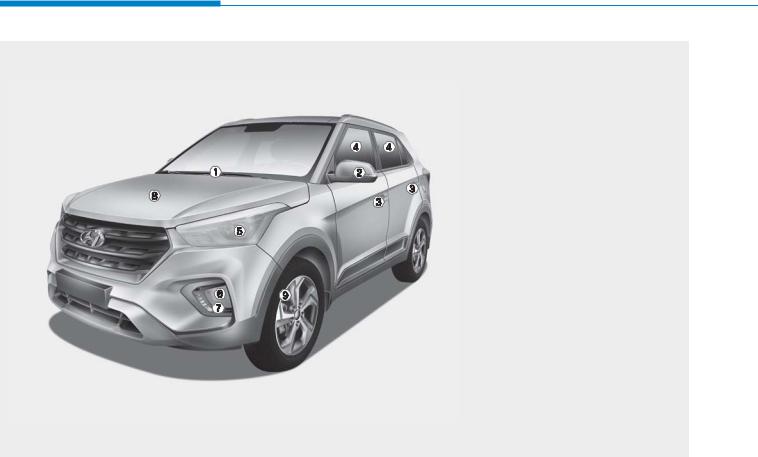
Your vehicle at a glance
EXTERIOR OVERVIEW (I)
■ Front view
1. |
Front windshield wiper blades |
...............7-45 |
2. |
Outside rearview mirror......................... |
3-40 |
3. Door....................................................... |
3-13 |
|
4. Windows ................................................ |
3-19 |
|
5. |
Head light .............................................. |
7-79 |
6. |
Front fog light* ....................................... |
7-80 |
7. |
Daytime running light* ........................... |
7-79 |
8. Hood...................................................... |
3-28 |
|
9. Tires and wheels ................................... |
7-51 |
|
* : if equipped |
|
|
The actual shape may differ from the illustration.
OGS018001L
1-2
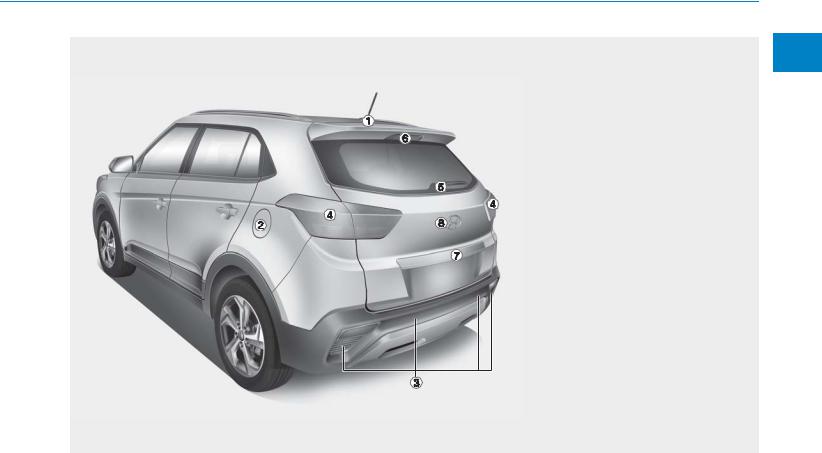
EXTERIOR OVERVIEW (II)
■ Rear view
1. Antenna ................................................... |
4-3 |
|
2. |
Fuel filler lid ........................................... |
3-30 |
3. |
Rear parking assist system* ................. |
3-92 |
4. Rear combination lamp ......................... |
7-83 |
|
5. Rear window wiper blade ...................... |
7-45 |
|
6. High mounted stop lamp ....................... |
7-85 |
|
7. Rearview camera*................................. |
3-91 |
|
8. Tailgate .................................................. |
3-33 |
|
* : if equipped |
|
|
The actual shape may differ from the illustration.
OGS018002L
1
glance a at vehicle Your
1-3
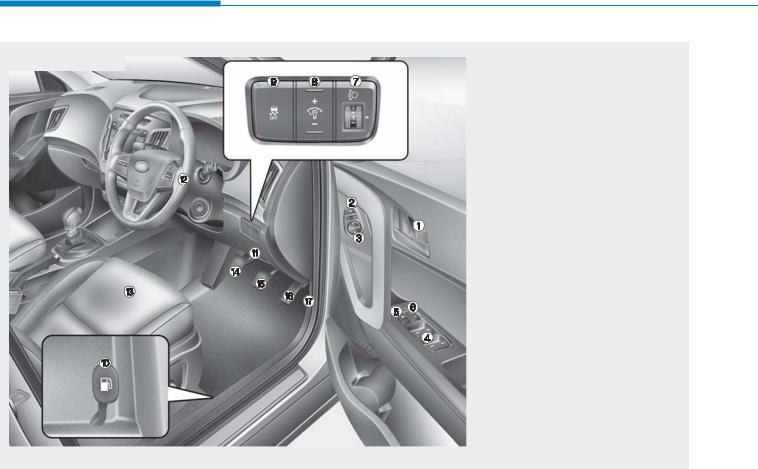
Your vehicle at a glance
INTERIOR OVERVIEW (I)
■ Right Hand Drive
The actual shape may differ from the illustration.
1. |
Door lock/unlock button .................... |
3-15 |
|
2. |
Outside rearview mirror folding |
|
|
|
switch* .............................................. |
3-42 |
|
3. |
Outside rearview mirror control |
|
|
|
switch* .............................................. |
3-41 |
|
4. Power window switches* .................. |
3-19 |
||
5. Power window lock switch*................ |
3-22 |
||
6. |
Central door lock switch .................... |
3-15 |
|
7. |
Headlight leveling device* ................ |
3-85 |
|
8. |
Instrument panel illumination |
|
|
|
control switch* .................................. |
3-44 |
|
9. ESC OFF switch * ............................ |
5-36 |
||
10. |
Fuel filler door opener .................... |
3-30 |
|
11. Fuse box.......................................... |
7-64 |
||
12. |
Steering wheel ................................ |
3-36 |
|
13. |
Seat .................................................. |
2-2 |
|
14. |
Clutch pedal* .................................. |
5-20 |
|
15. Brake pedal .................................... |
5-30 |
||
16. |
Accelerator pedal |
|
|
17. |
Hood release lever .......................... |
3-28 |
|
* : if equipped
OGS015002
1-4
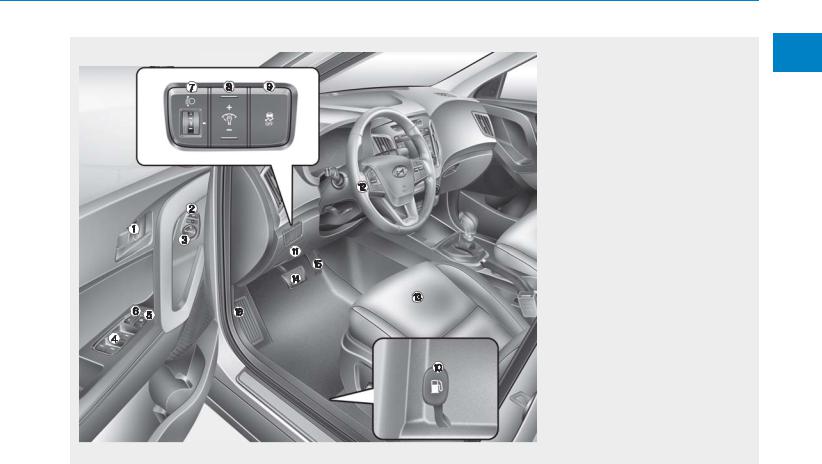
INTERIOR OVERVIEW (II)
■ Left Hand Drive
The actual shape may differ from the illustration.
1. |
Door lock/unlock button .................... |
3-15 |
|
2. |
Outside rearview mirror folding |
|
|
|
switch* .............................................. |
3-42 |
|
3. |
Outside rearview mirror control |
|
|
|
switch* .............................................. |
3-41 |
|
4. Power window switches* .................. |
3-19 |
||
5. Power window lock switch*................ |
3-22 |
||
6. |
Central door lock switch .................... |
3-15 |
|
7. |
Headlight leveling device* ................ |
3-85 |
|
8. |
Instrument panel illumination |
|
|
|
control switch* .................................. |
3-44 |
|
9. ESC OFF switch * ............................ |
5-36 |
||
10. |
Fuel filler door opener .................... |
3-30 |
|
11. Fuse box.......................................... |
7-64 |
||
12. |
Steering wheel ................................ |
3-36 |
|
13. |
Seat .................................................. |
2-2 |
|
14. Brake pedal .................................... |
5-30 |
||
15. |
Accelerator pedal |
|
|
16. |
Hood release lever .......................... |
3-28 |
|
* : if equipped
OGS015002L
1
glance a at vehicle Your
1-5
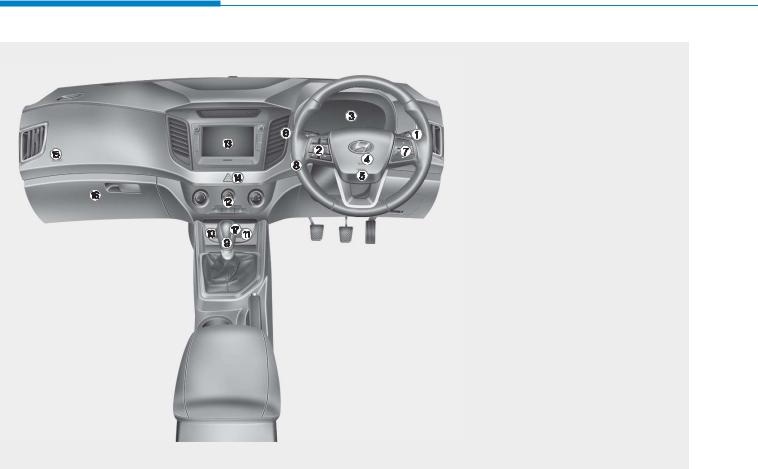
Your vehicle at a glance
INSTRUMENT PANEL OVERVIEW (I)
■ Right Hand Drive |
|
|
|
1. |
Light control/Turn signals .................. |
|
3-78 |
2. |
Steering wheel audio controls* |
............4-4 |
|
3. |
Instrument cluster.............................. |
|
3-43 |
4. Horn .................................................. |
|
3-37 |
|
5. |
Driver's front air bag* ........................ |
|
2-49 |
6. Wiper/Washer .................................... |
|
3-88 |
|
7. Trip mode switch*/Cruise control switch* |
|||
|
................................................ |
|
3-67, 5-43 |
8. |
Engine Start/Stop button / |
|
|
|
Key ignition switch........................ |
|
5-5, 5-9 |
9. Transaxle Gear Shift lever ................ |
|
5-19 |
|
10. Power outlet / USB charger .......... |
|
3-125 |
|
11. Cigarette lighter ............................ |
|
3-122 |
|
12. Climate control system ........ |
3-96, 3-105 |
||
13. Audio system*.................................. |
|
4-18 |
|
14. Hazard switch .................................... |
|
6-2 |
|
15. Passenger's front air bag* .............. |
|
2-50 |
|
16. Glove box ...................................... |
|
3-121 |
|
17. USB and iPod® port .......................... |
|
4-2 |
|
* : if equipped |
|
|
|
The actual shape may differ from the illustration.
OGS018003
1-6
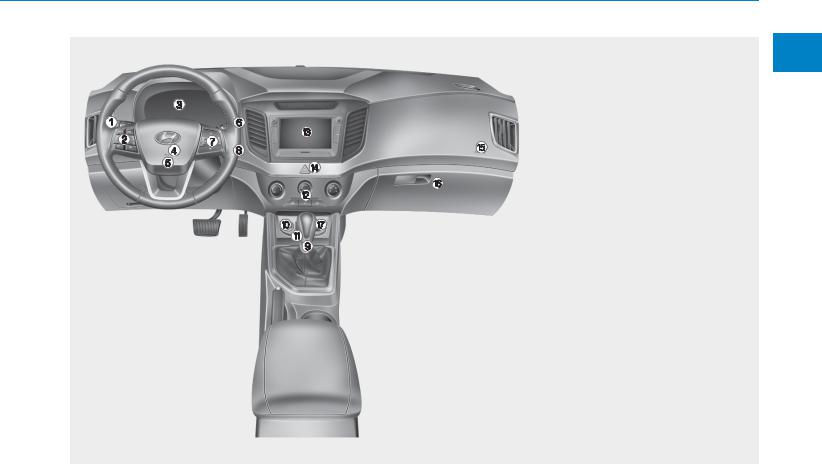
INSTRUMENT PANEL OVERVIEW (II)
■ Left Hand Drive
1. |
Light control/Turn signals .................. |
|
3-78 |
2. |
Steering wheel audio controls* |
............4-4 |
|
3. |
Instrument cluster.............................. |
|
3-43 |
4. Horn .................................................. |
|
3-37 |
|
5. |
Driver's front air bag* ........................ |
|
2-49 |
6. Wiper/Washer .................................... |
|
3-88 |
|
7. Trip mode switch*/Cruise control switch* |
|||
|
................................................ |
|
3-67, 5-43 |
8. |
Engine Start/Stop button / |
|
|
|
Key ignition switch........................ |
|
5-5, 5-9 |
9. Transaxle Gear Shift lever ................ |
|
5-19 |
|
10. Cigarette lighter ............................ |
|
3-122 |
|
11. USB and iPod® port* ........................ |
|
4-2 |
|
12. Climate control system ........ |
3-96, 3-105 |
||
13. Audio system*.................................. |
|
4-18 |
|
14. Hazard switch .................................... |
|
6-2 |
|
15. Passenger's front air bag* .............. |
|
2-50 |
|
16. Glove box ...................................... |
|
3-121 |
|
17. Power outlet / USB charger .......... |
|
3-125 |
|
* : if equipped |
|
|
|
The actual shape may differ from the illustration.
OGS018003L
1
glance a at vehicle Your
1-7

Your vehicle at a glance
ENGINE COMPARTMENT (I)
■Gasoline Engine (Gamma 1.6 MPI)
-Right Hand Drive
- Left Hand Drive
The actual engine room in the vehicle may differ from the illustration.
1. |
Engine oil filler cap........................... |
7-33 |
2. |
Engine oil dipstick ............................ |
7-32 |
3. |
Brake/clutch* fluid reservoir ............. |
7-37 |
4. Fuse box .......................................... |
7-66 |
|
5. |
Air cleaner ........................................ |
7-41 |
6. |
Radiator cap..................................... |
7-34 |
7. |
Engine coolant reservoir .................. |
7-35 |
8. Windshield washer fluid reservoir .... |
7-39 |
|
* : if equipped |
|
|
OGS076102/OGS076102L
1-8
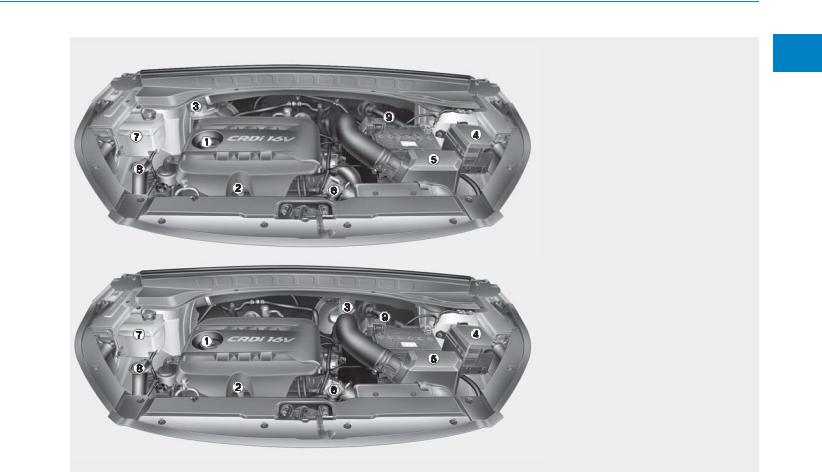
ENGINE COMPARTMENT (II)
■Diesel Engine (U2 1.4/1.6 TCI)
-Right Hand Drive
- Left Hand Drive
The actual engine room in the vehicle may differ from the illustration.
1. |
Engine oil filler cap........................... |
7-32 |
2. |
Engine oil dipstick ............................ |
7-32 |
3. |
Brake/clutch* fluid reservoir ............. |
7-37 |
4. Fuse box .......................................... |
7-66 |
|
5. |
Air cleaner ........................................ |
7-41 |
6. |
Radiator cap..................................... |
7-34 |
7. |
Engine coolant reservoir .................. |
7-35 |
8. Windshield washer fluid reservoir .... |
7-39 |
|
9. |
Fuel filter .......................................... |
7-40 |
* : if equipped |
|
|
OGS075001/OGS075001L
1
glance a at vehicle Your
1-9
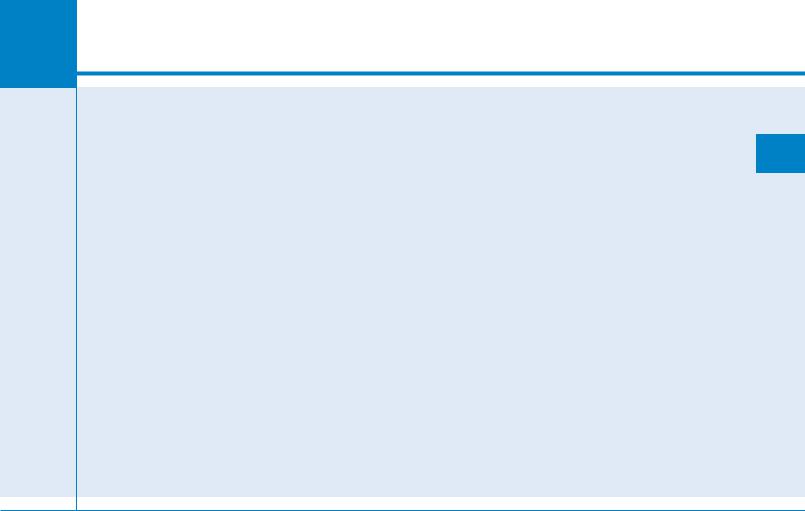
Safety system of your vehicle
Seats ....................................................................... |
2-2 |
Front seats ....................................................................... |
2-7 |
Rear seats ........................................................................ |
2-14 |
Seat belts .............................................................. |
2-19 |
Pre-tensioner seat belt ................................................ |
2-25 |
Additional seat belt safety precautions ................... |
2-27 |
Care of seat belts ........................................................... |
2-30 |
Child restraint system ......................................... |
2-31 |
Children always in the rear ......................................... |
2-31 |
Installing a Child Restraint System (CRS).................. |
2-33 |
Air bag-supplemental restraint system(SRS).. |
2-43 |
How does the air bag system operate ..................... |
2-45 |
Do not install a child restraint on the |
|
front passenger's seat................................................... |
2-47 |
Air bag warning and indicator..................................... |
2-48 |
SRS components and functions .................................. |
2-48 |
Driver's and passenger's front air bag .................... |
2-52 |
Side impact air bag ........................................................ |
2-55 |
Curtain air bag ................................................................ |
2-56 |
SRS Care............................................................................ |
2-63 |
Air bag warning label .................................................... |
2-65 |
2
vehicle your of system Safety
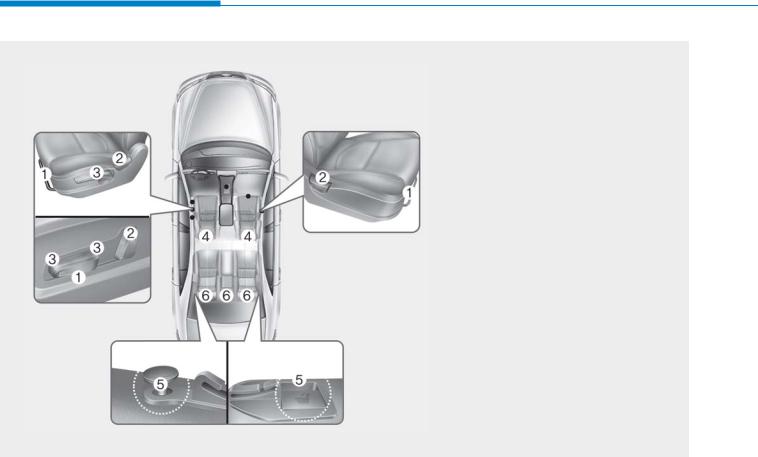
Safety system of your vehicle
SEATS
■ Left-hand drive
Front seats
1. Seat adjustment, forward/rearward
2. Seatback angle
3. Seat adjustment, height*
4. Headrest adjustment
Rear seats
5. Seat folding*
6. Headrest adjustment* * : if equipped
■ Type A |
■ Type B |
The actual feature in the vehicle may differ from the illustration.
OGS035001L
2-2

■ Right-hand drive
Front seats
1. Seat adjustment, forward/rearward
2. Seatback angle
3. Seat adjustment, height*
4. Headrest adjustment
Rear seats
5. Seat folding*
6. Headrest adjustment* * : if equipped
■ Type A |
■ Type B |
The actual feature in the vehicle may differ from the illustration.
OGS035001
2-3
2
vehicle your of system Safety

Safety system of your vehicle
 WARNING
WARNING
Loose objects
Loose objects in the driver’s foot area could interfere with the operation of the foot pedals, possibly causing an accident. Do not place anything under the front seats.
 WARNING
WARNING
Uprighting seat
When you return the seatback to its upright position, hold the seatback and return it slowly and be sure there are no other occupants around the seat. If the seatback is returned without being held and controlled, the back of the seat could move forward or backward resulting in accidental injury to a person struck by the seatback.
 WARNING
WARNING
Driver responsibility for passengers
Riding in a vehicle with seatback reclined could lead to serious or fatal injury in an accident. If a seat is reclined during an accident, the occupant’s hips may slide under the lap portion of the seat belt applying great force to the unprotected abdomen. The protection of your restraint system (seat belt and air bags) is greatly reduced by reclining your seat. Serious or fatal internal injuries could result. The driver must advise the passenger to keep the seatback in an upright position whenever the vehicle is in motion.
 WARNING
WARNING
Do not use a sitting cushion that reduces friction between the seat and passenger. The passenger's hips may slide under the lap portion of the seat belt during an accident or a sudden stop. Serious or fatal internal injuries could result because the seat belt can't operate normally.
2-4
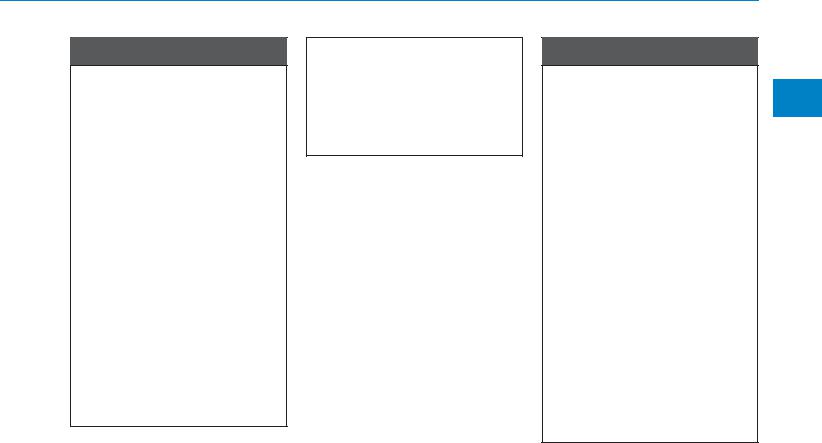
 WARNING
WARNING
Driver’s seat
•Never attempt to adjust seat while the vehicle is moving. This could result in loss of control, and an accident causing death, serious injury, or property damage.
•Do not allow anything to interfere with the normal position of the seatback. Storing items against a seatback or in any other way interfering with proper locking of a seatback could result in serious or fatal injury in a sudden stop or collision.
•Always drive and ride with your seatback upright and the lap portion of the seat belt snug and low across the hips. This is the best position to protect you in case of an accident.
(Continued)
(Continued)
•In order to avoid unnecessary and perhaps severe air bag injuries, always sit as far back as possible from the steering wheel while maintaining comfortable control of the vehicle.
 WARNING
WARNING
Rear seatbacks
•The rear seatback must be securely latched. If not, passengers and objects could be thrown forward resulting in serious injury or death in the event of a sudden stop or collision.
•Luggage and other cargo should be laid flat in the cargo area. If objects are large, heavy, or must be piled, they must be secured. Under no circumstances should cargo be piled higher than the seatbacks. Failure to follow these warnings could result in serious injury or death in the event of a sudden stop, collision or rollover.
•No passenger should ride in the cargo area or sit or lie on folded seatbacks while the vehicle is moving. All passengers must be properly seated in seats and restrained properly while riding.
(Continued)
2-5
2
vehicle your of system Safety
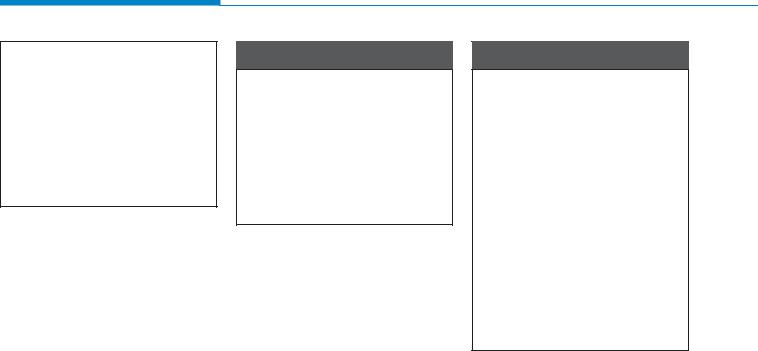
Safety system of your vehicle
(Continued)
•When resetting the seatback to the upright position, make sure it is securely latched by pushing it forward and backwards.
•To avoid the possibility of burns, do not remove the carpet in the cargo area. Emission control devices beneath this floor generate high temperatures.
 WARNING
WARNING
After adjusting the seat, always check that it is securely locked into place by attempting to move the seat forward or backward without using the lock release lever. Sudden or unexpected movement of the driver's seat could cause you to lose control of the vehicle resulting in an accident.
 WARNING
WARNING
•Do not adjust the seat while wearing seat belts. Moving the seat cushion forward may cause strong pressure on the abdomen.
•Use extreme caution so that hands or other objects are not caught in the seat mechanisms while the seat is moving.
•Do not put a cigarette lighter on the floor or seat. When you operate the seat, gas may gush out of the lighter and cause fire.
•If there are occupants in the rear seats, be careful while adjusting the front seat position.
2-6
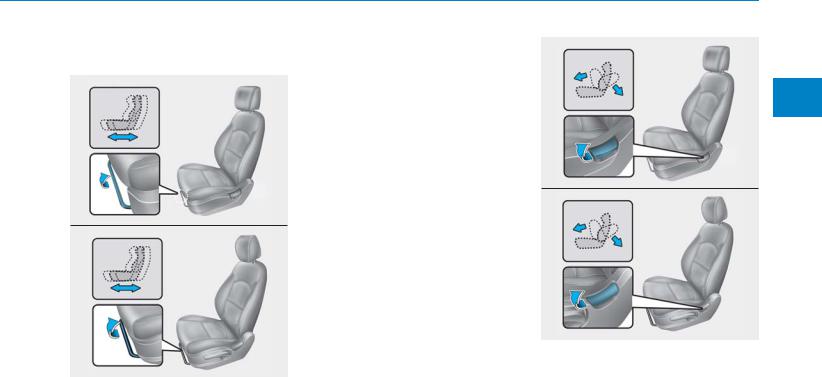
Front seats
Manual adjustment
■ Type A
OGS038002L
■ Type B
OGS038003L
Forward and rearward
To move the seat forward or rearward:
1.Pull the seat slide adjustment lever up and hold it.
2.Slide the seat to the position you desire.
3.Release the lever and make sure the seat is locked in place.
Adjust the seat before driving, and make sure the seat is locked securely by trying to move forward and rearward without using the lever. If the seat moves, it is not locked properly.
■ Type A
OGS038022L
■ Type B
OGS038004L
Seatback angle
To recline the seatback:
1.Lean forward slightly and lift up on the seatback recline lever.
2.Carefully lean back on the seat and adjust the seatback of the seat to the position you desire.
2
vehicle your of system Safety
2-7
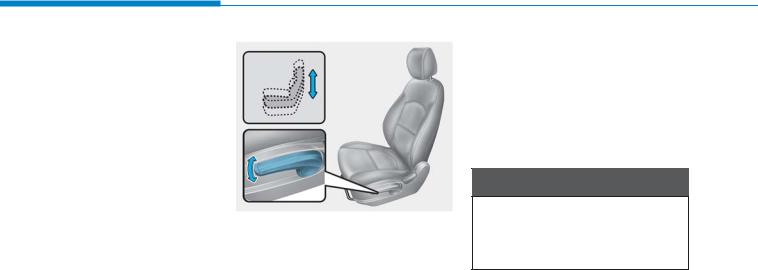
Safety system of your vehicle
3.Release the lever and make sure the seatback is locked in place. (The lever MUST return to its original position for the seatback to lock.)
OGS038005L
Seat cushion height
(for driver’s seat, if equipped)
To change the height of the seat cushion, move the lever upwards or downwards.
•To lower the seat cushion, push the lever down several times.
•To raise the seat cushion, pull the lever up several times.
Power adjustment
The driver’s seat can be adjusted by using the control knob located on the outside of the seat cushion. Before driving, adjust the seat to the proper position so as to easily control the steering wheel, pedals and switches on the instrument panel.
 WARNING
WARNING
NEVER allow children in the vehicle unattended. The power seats are operable when the engine is turned off.
2-8

NOTICE
To prevent damage to the seats:
•Always stop adjusting the seats when the seat has been adjusted as far forward or rearward as possible.
•Do not adjust the seats longer than necessary when the engine is turned off. This may result in unnecessary battery drain.
•Do not operate two or more seats at the same time. This may result in an electrical malfunction.
OGS038006L
Forward and rearward
Push the control switch forward or backward to move the seat to the desired position. Release the switch once the seat reaches the desired position.
OGS038007L
Seatback angle
Push the control switch forward or backward to move the seatback to the desired angle. Release the switch once the seat reaches the desired position.
2-9
2
vehicle your of system Safety
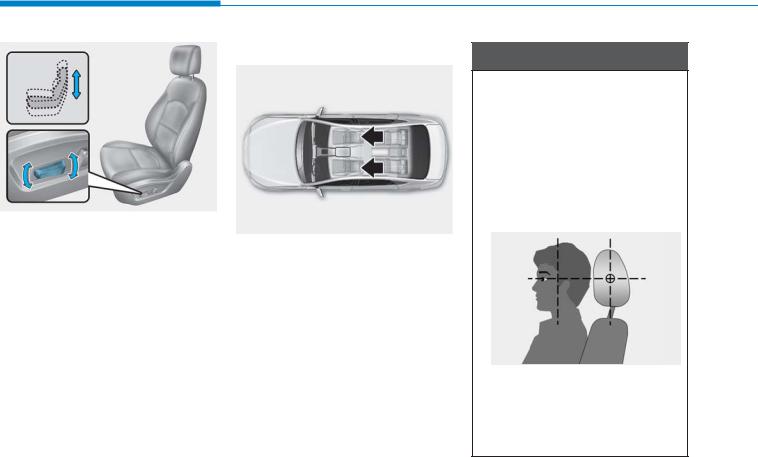
Safety system of your vehicle
OGS038008L
Seat cushion height
(for driver’s seat, if equipped)
Pull the front portion of the control switch up to raise or down to lower the front part of the seat cushion. Pull the rear portion of the control switch up to raise or down to lower the seat. Release the switch once the seat reaches the desired position.
Headrest
ODH033105L
The driver's and front passenger's seats are equipped with a headrest for the occupant's safety and comfort.
The headrest not only provides comfort for the driver and front passenger, but also helps to protect the head and neck in the event of a collision.
 WARNING
WARNING
To reduce the risk of serious injury or death in an accident, take the following precautions when adjusting your headrests:
•Always properly adjust the headrests for all passengers BEFORE starting the vehicle.
•NEVER let anyone ride in a seat with the headrests removed.
•
OLF034072N
Adjust the headrests so the middle of the headrests is at the same height as the height of the top of the eyes.
(Continued)
2-10
